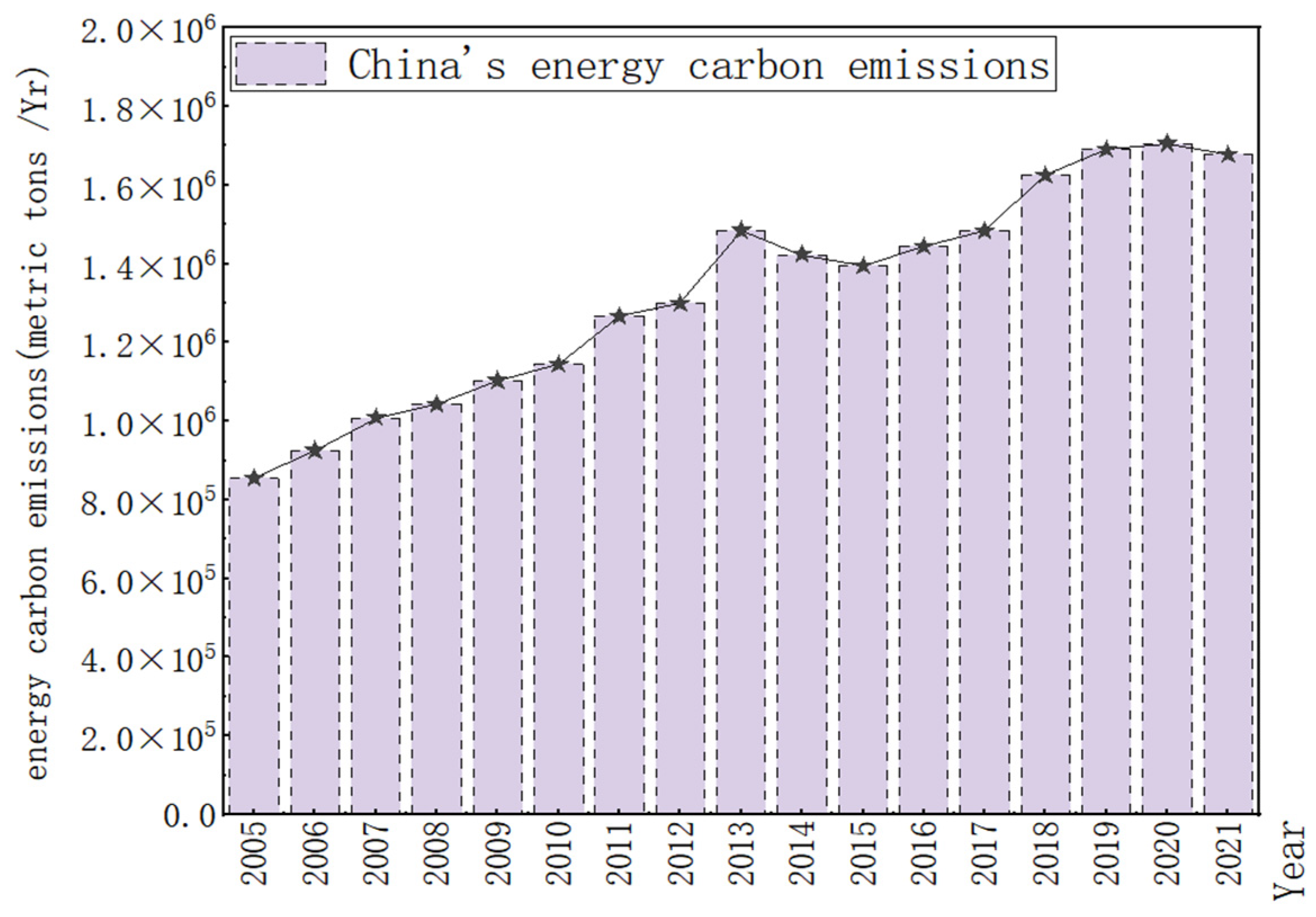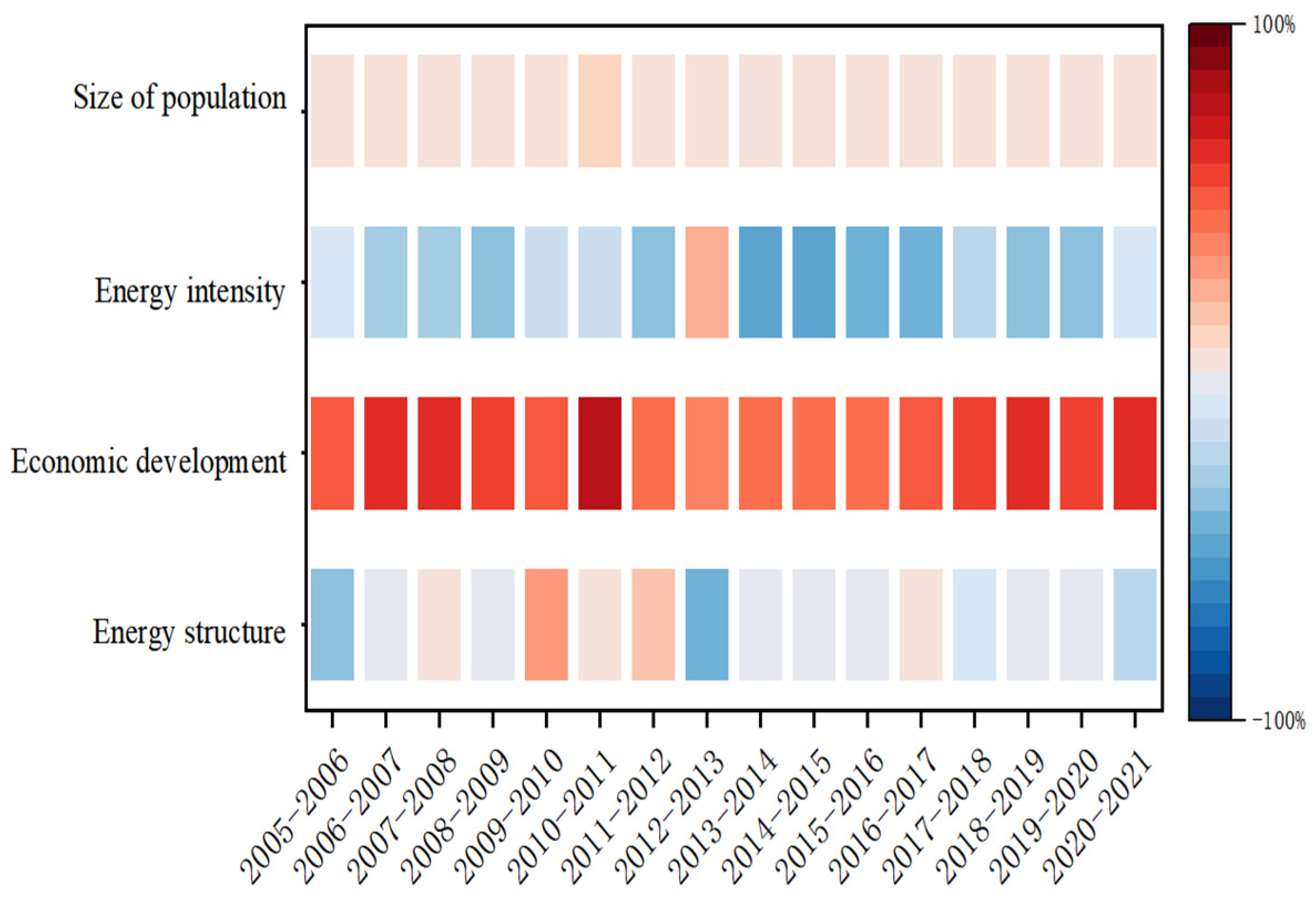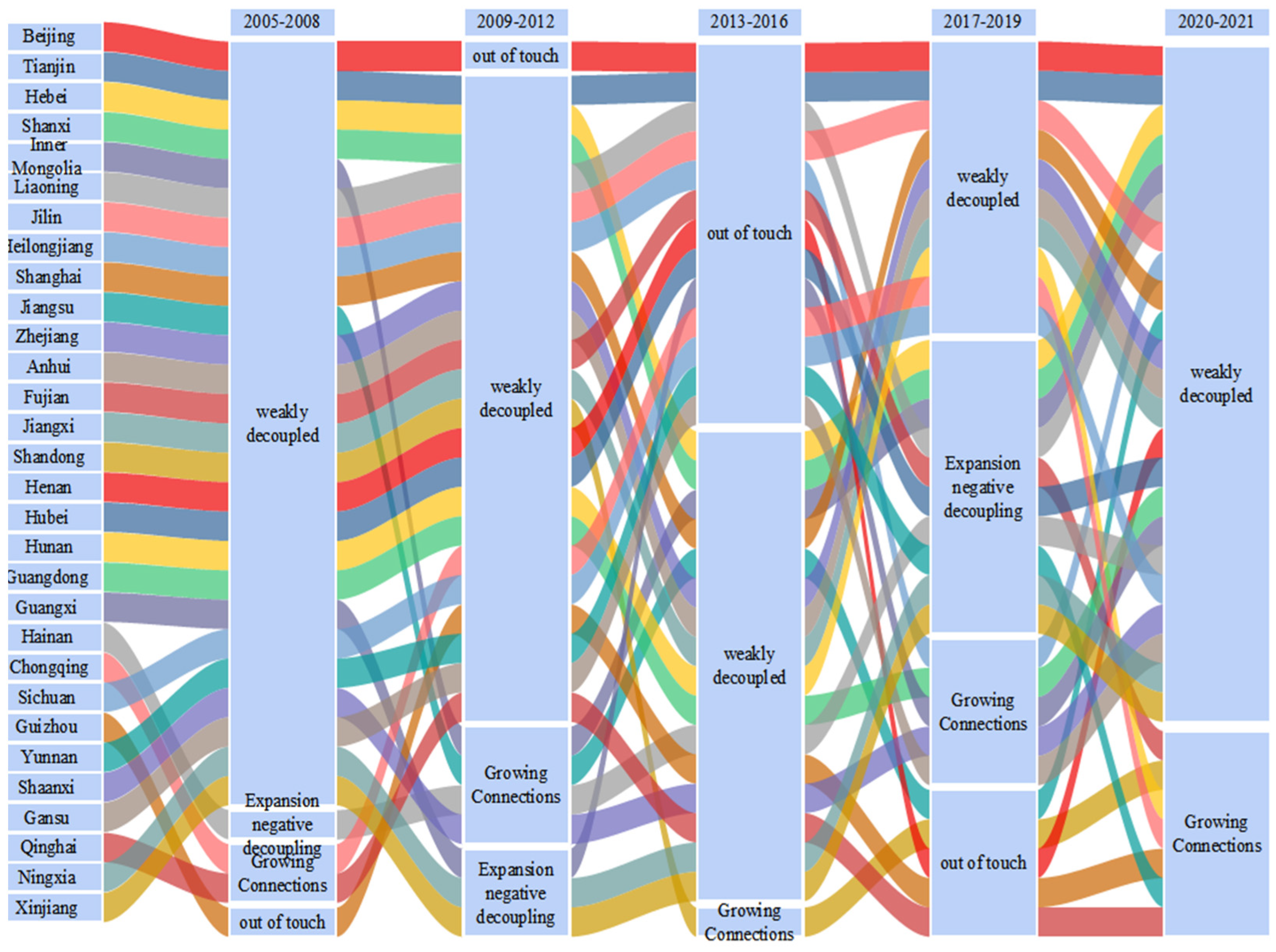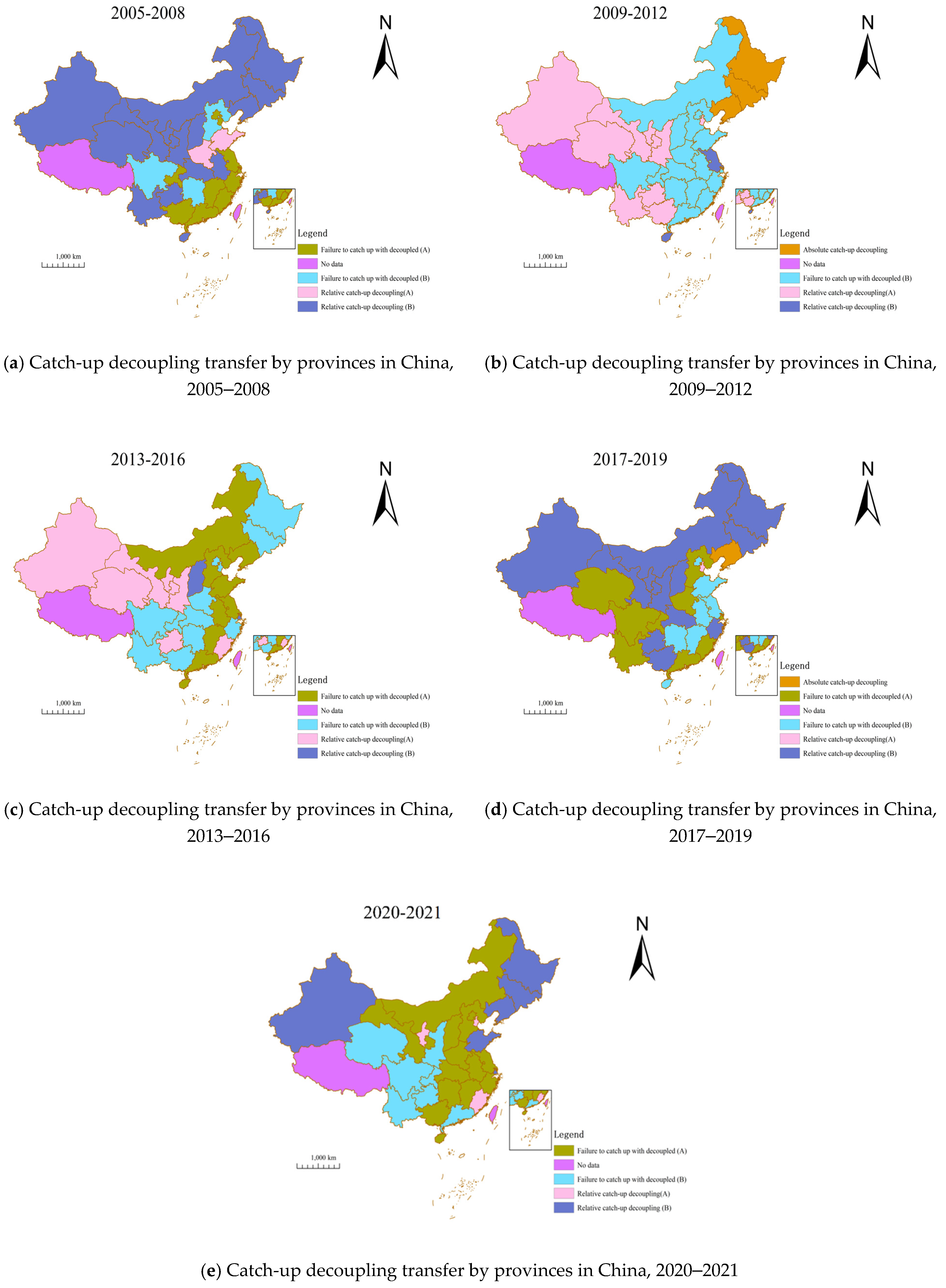Analysis of the Spatial and Temporal Evolution of China’s Energy Carbon Emissions, Driving Mechanisms, and Decoupling Levels
Abstract
:1. Introduction
2. Materials and Methods
2.1. Carbon Emission Accounting Methods
2.1.1. Accounting for Energy Carbon Emissions
2.1.2. Energy Carbon Intensity Accounting
2.2. Kernel Density Estimation
2.3. Classification of Carbon Emissions
2.4. Log Mean Divided Index (LMDI) Exponential Decomposition
2.5. Tapio’s Decoupling Index Model
2.6. Catch-Up Decoupling Model
2.7. Explanatory Variables Selection and Description
3. Results
3.1. Characteristics of Spatial and Temporal Changes in Energy Carbon Emissions
3.1.1. Time Evolution Characteristics
3.1.2. Characteristics of Spatial Evolution
3.1.3. Analysis of the Dynamic Evolution of Disequilibrium
3.2. Classification of Carbon Emissions
3.3. Analysis of the Driving Mechanism of China’s Energy Carbon Emissions
3.4. Decoupling of Carbon Emissions from Economic Development at the Inter-Provincial Level in China
3.4.1. Overall Decoupling of Carbon Emissions from Economic Development at the Inter-Provincial Level
3.4.2. Analysis of Decoupling Transfers
3.4.3. Catch-Up Decoupling Analysis
4. Conclusions and Policy Recommendations
Conclusions
- (1)
- National level
- (2)
- Provincial level
5. Limitations and Prospects
Author Contributions
Funding
Institutional Review Board Statement
Informed Consent Statement
Data Availability Statement
Conflicts of Interest
Appendix A
| Year | 2005 | 2006 | 2007 | 2008 | 2009 | 2010 | 2011 | 2012 | 2013 | 2014 | 2015 | 2016 | 2017 | 2018 | 2019 | 2020 | 2021 | |
|---|---|---|---|---|---|---|---|---|---|---|---|---|---|---|---|---|---|---|
| Region | ||||||||||||||||||
| Beijing | 11,998.62 | 12,327.388 | 13,113.708 | 13,336.661 | 13,679.251 | 13,867.019 | 12,932.269 | 13,139.232 | 12,074.419 | 12,511.52 | 12,144.764 | 11,496.04 | 11,288.46 | 11,565.706 | 11,524.71 | 11,654.88 | 12,568.55 | |
| Tianjin | 12,488.522 | 13,293.075 | 14,127.898 | 14,055.932 | 15,107.56 | 18,436.843 | 20,231.116 | 20,377.362 | 21,142.105 | 20,419.87 | 20,158.968 | 19,033.916 | 18,905.176 | 19,623.763 | 19,788.62 | 20,147.33 | 21,456.44 | |
| Hebei | 57,412.516 | 61,942.581 | 67,607.595 | 70,642.242 | 75,350.813 | 81,068.028 | 91,675.929 | 92,966.828 | 93,243.415 | 88,685.007 | 92,733.758 | 92,865.965 | 92,193.492 | 94,559.178 | 94,913.14 | 10,4878.33 | 106,589.12 | |
| Shanxi | 56,159.395 | 62,219.48 | 64,241.45 | 63,124.779 | 62,530.73 | 67,088.454 | 73,955.093 | 77,225.595 | 79,194.815 | 81,095.64 | 93,090.316 | 92,133.059 | 97,087.731 | 103,926.66 | 109,327.2 | 115,200.55 | 125,633.31 | |
| Inner Mongolia | 31,179.32 | 36,618.267 | 42,270.083 | 50,463.686 | 54,940.466 | 60,551.772 | 75,579.624 | 78,531.547 | 76,723.589 | 78,612.072 | 77,969.182 | 78,887.758 | 83,004.003 | 95,196.635 | 105,600.2 | 115,268.14 | 123,456.22 | |
| Liaoning | 49,813.984 | 53,546.913 | 57,952.996 | 59,414.946 | 61,512.03 | 67,401.813 | 71,990.851 | 74,604.894 | 71,921.114 | 72,027.084 | 69,545.834 | 70,442.413 | 72,570.98 | 77,177.94 | 84,066.75 | 94,066.755 | 96,541.36 | |
| Jilin | 18,427.643 | 20,086.88 | 21,219.444 | 22,019.111 | 22,525.58 | 25,131.01 | 28,754.483 | 28,415.645 | 27,380.831 | 27,158.152 | 23,184.056 | 22,859.128 | 22,682.756 | 23,468.747 | 24,176.49 | 25,796.34 | 26,896.85 | |
| Heilongjiang | 25,149.453 | 26,565.226 | 28,570.084 | 30,305.328 | 31,646.141 | 34,319.075 | 36,805.972 | 38,555.263 | 36,586.454 | 37,082.37 | 33,939.679 | 34,224.632 | 34,248.898 | 34,931.633 | 36,671.46 | 37,898.666 | 38,744.223 | |
| Shanghai | 23,128.306 | 23,039.481 | 23,657.101 | 24,791.424 | 24,681.47 | 27,004.166 | 27,780.521 | 27,389.171 | 29,052.531 | 26,454.763 | 26,564.044 | 26,471.325 | 26,967.67 | 26,550.202 | 27,403.58 | 29,635.224 | 29,888.22 | |
| Jiangsu | 47,340.372 | 51,815.725 | 55,854.135 | 57,632.443 | 60,246.025 | 67,259.233 | 77,527.449 | 79,158.29 | 81,395.446 | 80,822.449 | 83,706.697 | 87,125.359 | 86,307.475 | 85,537.563 | 87,372.58 | 88,746.32 | 92,746.32 | |
| Zhejiang | 29,982.72 | 33,830.376 | 37,798.321 | 38,546.641 | 40,080.3 | 43,024.865 | 45,569.253 | 44,210.237 | 45,473.688 | 44,952.697 | 45,583.628 | 45,243.106 | 47,384.075 | 46,475.895 | 47,476.50 | 48,746.369 | 49,746.369 | |
| Anhui | 19,693.454 | 21,189.638 | 23,602.034 | 26,945.052 | 29,653.55 | 31,428.394 | 34,147.836 | 35,238.853 | 38,271.91 | 39,541.489 | 39,619.898 | 39,553.309 | 40,938.104 | 42,504.565 | 42,779.28 | 43,779.285 | 44,779.285 | |
| Fujian | 13,451.65 | 14,719.621 | 16,501.447 | 17,262.755 | 20,448.583 | 22,721.407 | 25,938.656 | 25,739.451 | 25,273.295 | 28,834.236 | 27,727.986 | 26,018.475 | 27,412.794 | 30,337.484 | 32,290.43 | 34,521.356 | 38,521.356 | |
| Jiangxi | 11,730.639 | 12,799.931 | 13,982.176 | 14,209.29 | 14,875.145 | 17,300.321 | 23,669.643 | 19,208.941 | 20,697.428 | 21,081.452 | 21,969.719 | 22,259.928 | 22,729.037 | 23,758.601 | 24,266.73 | 26,456.369 | 29,456.369 | |
| Shandong | 70,074.78 | 78,711.097 | 87,506.502 | 94,495.691 | 98,401.375 | 108,777.02 | 110,085.24 | 120,622.48 | 117,437.23 | 125,785.31 | 138,498.17 | 145,505.03 | 149,306.95 | 147,839.73 | 151,698.2 | 174,596.33 | 194,596.33 | |
| Henan | 42,521.633 | 48,219.488 | 53,375.018 | 55,077.511 | 56,281.441 | 60,866.511 | 67,090.084 | 62,784.57 | 62,311.133 | 62,987.968 | 59,313.762 | 58,626.372 | 57,379.914 | 57,717.863 | 53,398.49 | 60,245.734 | 62,245.734 | |
| Hubei | 23,951.237 | 26,514.086 | 29,337.711 | 29,358.838 | 31,527.241 | 36,156.131 | 41,145.958 | 41,171.968 | 35,834.787 | 36,282.25 | 34,444.153 | 34,258.002 | 35,062.216 | 36,458.122 | 38,710.66 | 39,443.35 | 42,443.35 | |
| Hunan | 22,660.181 | 24,173.136 | 26,557.418 | 26,295.89 | 27,656.68 | 29,342.556 | 32,755.442 | 32,264.79 | 31,382.114 | 30,470.505 | 30,348.687 | 31,037.192 | 31,337.817 | 32,037.033 | 31,947.22 | 33,467.521 | 36,467.521 | |
| Guangdong | 38,711.841 | 43,109.337 | 46,767.907 | 48,240.277 | 52,047.24 | 57,628.255 | 63,557.26 | 61,867.836 | 62,952.558 | 63,402.06 | 63,996.629 | 66,114.53 | 69,203.562 | 71,499.158 | 70,979.04 | 78,465 | 82,465 | |
| Guangxi | 10,261.545 | 11,265.167 | 12,868.063 | 12,757.037 | 14,148.72 | 17,212.221 | 21,173.247 | 23,254.117 | 23,380.218 | 23,210.166 | 21,791.625 | 22,655.55 | 23,965.271 | 25,181.685 | 26,628.65 | 27,728.365 | 28,728.223 | |
| Hainan | 1598.842 | 2428.628 | 4409.141 | 4671.755 | 4966.895 | 5423.367 | 6392.068 | 6662.906 | 6190.831 | 6849.103 | 7498.034 | 7278.204 | 7070.089 | 7482.044 | 7685.407 | 7885.239 | 8085.698 | |
| Chongqing | 9068.654 | 9834.204 | 10,715.227 | 13,268.907 | 14,269.873 | 15,754.548 | 17,945.746 | 17,713.05 | 15,341.73 | 16,441.897 | 14,420.451 | 14,862.151 | 15,321.748 | 15,422.782 | 15,565.26 | 16,565.665 | 18,565.333 | |
| Sichuan | 21,609.477 | 24,174.667 | 27,013.884 | 29,831.582 | 33,567.332 | 34,594.562 | 34,904.466 | 36,346.76 | 37,329.405 | 38,653.411 | 33,105.502 | 32,553.343 | 31,964.3 | 31,171.36 | 33,463.12 | 34,463.887 | 36,463.635 | |
| Guizhou | 18,222.234 | 21,208.949 | 22,687.785 | 21,057.055 | 23,065.929 | 23,247.165 | 25,705.446 | 28,128.194 | 29,204.301 | 28,206.238 | 28,228.924 | 29,571.299 | 29,741.36 | 27,410.37 | 28,084.69 | 29,410.987 | 32,410.336 | |
| Yunnan | 17,688.943 | 19,464.585 | 20,336.834 | 20,922.611 | 22,713.016 | 23,979.158 | 24,755.196 | 25,707.336 | 25,436.331 | 22,871.815 | 20,711.095 | 20,486.29 | 21,760.629 | 24,186.349 | 25,297.39 | 26,300.446 | 29,300.332 | |
| Shaanxi | 17,646.677 | 21,437.586 | 23,661.633 | 26,659.738 | 28,966.349 | 34,307.235 | 37,930.583 | 43,553.726 | 46,265.637 | 48,745.6 | 48,264.732 | 49,160.574 | 50,667.473 | 49,574.909 | 53,839.69 | 57,555.338 | 60,555.225 | |
| Gansu | 12,953.157 | 13,819.341 | 15,370.926 | 15,672.057 | 15,476.926 | 17,227.728 | 19,902.132 | 20,497.592 | 21,197.156 | 21,348.103 | 20,648.926 | 19,863.062 | 20,038.48 | 20,992.541 | 21,253.85 | 26,666.125 | 27,666.898 | |
| Qinghai | 2344.101 | 2944.23 | 3266.284 | 4067.184 | 4142.595 | 4133.085 | 4885.542 | 5824.752 | 6414.459 | 5985.861 | 5525.828 | 6435.889 | 6167.295 | 6032.492 | 5963.033 | 6422.001 | 7422.456 | |
| Ningxia | 7310.221 | 8008.046 | 9057.795 | 10,009.469 | 11,008.736 | 13,027.29 | 17,343.634 | 18,634.516 | 19,829.671 | 20,184.71 | 20,957.493 | 20,860.469 | 25,644.47 | 28,583.99 | 31,066.64 | 35,100.045 | 38,100.693 | |
| Xinjiang | 15,402.079 | 17,550.824 | 19,107.481 | 21,153.436 | 24,690.738 | 27,656.497 | 32,715.645 | 37,794.645 | 43,279.765 | 48,110.51 | 49,709.02 | 51,870.247 | 55,171.86 | 57,433.832 | 61,079.01 | 63,000.123 | 65,055.361 | |
References
- Mishra, A.; Alavi, S. Green energy, carbon emission and economic prosperity: An evidence of global perspective. Int. J. Energy Sect. Manag. 2023, 17, 661–676. [Google Scholar] [CrossRef]
- Yang, C.; Hao, Y.; Irfan, M. Energy consumption structural adjustment and carbon neutrality in the post-COVID-19 era. Struct. Chang. Econ. Dyn. 2021, 59, 442–453. [Google Scholar] [CrossRef] [PubMed]
- Doğan, M.; Raikhan, S.; Zhanar, N.; Gulbagda, B. Analysis of Dynamic Connectedness Relationships among Clean Energy, Carbon Emission Allowance, and BIST Indexes. Sustainability 2023, 15, 6025. [Google Scholar] [CrossRef]
- Wang, L.; Zhang, B. Factors Decomposition and Scenario Prediction of Energy elated CO2 Emissions in China. Electr. Power Constr. 2021, 42, 1–9. [Google Scholar]
- Quadrelli, R.; Peterson, S. The energy–climate challenge: Recent trends in CO2 emissions from fuel combustion. Energy Policy 2007, 35, 5938–5952. [Google Scholar] [CrossRef]
- Pan, D.; Li, N.; Li, F.; Feng, K.S.; Peng, L.; Wang, Z. Mitigation strategy of Eastern China based on energy-source carbon emission estimation. Acta Sci. Circumstantiae 2021, 41, 1142–1152. [Google Scholar]
- Nonini, L.; Fiala, M. Assessment of Forest Wood and Carbon Stock at the Stand Level: First Results of a Modeling Approach for an Italian Case Study Area of the Central Alps. Sustainability 2022, 14, 3989. [Google Scholar] [CrossRef]
- Chen, L.; Hang, Y.; Li, Q. Spatial-Temporal Characteristics and Influencing Factors of Carbon Emissions from Land Use and Land Cover in Black Soil Region of Northeast China Based on LMDI Simulation. Sustainability 2023, 15, 9334. [Google Scholar] [CrossRef]
- Paris, Y.K. Presentation to the Energy and Industry Subgroup. Response Strategies Working Group. In Proceedings of the IPCC Conference, Paris, France, 30 June 1989. [Google Scholar]
- Jiang, B.; Ma, S. A Study on the Factors Influencing Regional Economic Growth and Carbon Emissions: A Case Study of the Three Northeastern Provinces. Public Manag. 2020, 39, 122–131. [Google Scholar] [CrossRef]
- Liu, J. Research on the Influencing Factors of China’s Carbon Emission and the Countermeasures Based on the LMDI Model. Ind. Econ. 2022, 146–148. [Google Scholar] [CrossRef]
- Jiang, Q.; Lin, J.; Wei, Q.; Zhang, R.; Fu, H. Demystifying the Economic Growth and CO2 Nexus in Fujian’s Key Industries Based on Decoupling and LMDI Model. Sustainability 2023, 15, 3863. [Google Scholar] [CrossRef]
- Vaclovas, M.; Arvydas, G.; Viktorija, B.; Inga, K.; Eimantas, N. Impact of Key Drivers on Energy Intensity and GHG Emissions in Manufacturing in the Baltic States. Sustainability 2023, 15, 3330. [Google Scholar]
- Yu, R.; Huang, X.; Xu, G. Towards a Theory of Decoupling: The Relationship of Carbon Emission and Construction Land Expansion between 1997 and 2012 in Hefei City, China. Nat. Environ. Polution Technol. 2019, 18, 569–577. [Google Scholar]
- Qi, S.Z.; Lin, S.; Wang, B.B. Impact of Economic Growth Pattern of the Six Provinces of Central China on Regional Carbon Emission: Based on the Tapio Model and Lag Instrumental Variable Analysis of Panel Data. China Popul. Resour. Environ. 2015, 25, 59–66. [Google Scholar]
- Zhao, G.; Yin, C. Research on the Relationship Between Carbon Emission Efficiency and Economic Growth in Northeast China. J. Heilongjiang Inst. Technol. 2022, 36, 41–48. [Google Scholar] [CrossRef]
- Wang, A.; Guo, L.; Zhao, J. Analysis of the Temporal and Spatial Heterogeneity of Decoupling Between the Chinese Economy and Carbon Emissions and Its Driving Factors. Soft Sci. 2023, 11, 1–12. [Google Scholar]
- Li, X.Y.; Chen, T.; Chen, B. Research on the Influencing Factors and Decoupling State of Carbon Emissions in China’s Transportation Industry. Sustainability 2023, 15, 11871. [Google Scholar] [CrossRef]
- Zhu, L.; Yong, G.; Bing, X.; Fengming, X.; Jiangbo, J. A Calculation Method of CO2 Emission from Urban Energy Consumption. Resour. Sci. 2011, 33, 1325–1330. [Google Scholar]
- Yu, S.; Zhang, Q.; Hao, J.L.; Ma, W.; Sun, Y.; Wang, X.; Song, Y. Development of an extended STIRPAT model to assess the driving factors of household carbon dioxide emissions in China. J. Environ. Manag. 2023, 325, 116502. [Google Scholar] [CrossRef] [PubMed]
- Wang, Q.; Fu, L.; Sun, H. Regional differences, dynamic changes, and influencing factors of carbon emissions from industrial production energy consumption in China. Resour. Sci. 2023, 45, 1239–1254. [Google Scholar] [CrossRef]
- Han, C.; Song, F.; Teng, M. Temporal and Spatial Dynamic Characteristics, Spatial Clustering and Governance Strategies of Carbon Emissions in the Yangtze River Delta. East China Econ. Manag. 2022, 36, 24–33. [Google Scholar] [CrossRef]
- Sharif, A.; Bhattacharya, M.; Afshan, S.; Shahbaz, M. Disaggregated renewable energy sources in mitigating CO2 emissions: New evidence from the USA using quantile regressions. Environ. Sci. Pollut. Res. 2021, 28, 57582–57601. [Google Scholar] [CrossRef] [PubMed]
- Liu, M.; Deng, X.; Liu, S. Analysis of Carbon Emissions in Tianjin City Based on the LMDI Method and the Tapio Decoupling Model. Environ. Pollut. Control 2022, 44, 1397–1401. [Google Scholar] [CrossRef]
- Wang, M.; Feng, X.; An, Q. Study on green and low-carbon development in Qinghai province based on decoupling index and LMDI. Clim. Chang. Res. 2021, 17, 598–607. [Google Scholar]
- Ang, B.W.; Liu, N. Handling zero values in the logarithmic mean Divisia index decomposition approach. Energy Policy 2007, 35, 238–246. [Google Scholar] [CrossRef]
- Zhang, C.; Cai, W.; Yu, T. Regional Economic Growth and Carbon Productivity: An Analysis Based on Convergence and Decoupling Indices. China Ind. Econ. 2013, 18–30. [Google Scholar] [CrossRef]
- Tien-Tam, T.; Anis, F.; Chafik, S. Learning, inference, and prediction on probability density functions with constrained Gaussian processes. Inf. Sci. 2023, 642, 119068. [Google Scholar]
- Yang, Z. Research on the influencing factors of living energy consumption and carbon emissions based on spatiotemporal model. J. Comb. Optim. 2022, 45, 25. [Google Scholar]
- Qian, Y.; Wang, H.; Wu, J. Spatiotemporal association of carbon dioxide emissions in China’s urban agglomerations. J. Environ. Manag. 2022, 323, 116109. [Google Scholar] [CrossRef]
- Hua, R.; Lan, Y.; Li, J.; Jing, Y.; Jia, X.; Chai, Y.; Li, P. Analysis of Interprovincial Carbon Emission Decoupling Effects and Driving Factors in China. Res. Environ. Sci. 2023, 1–15. [Google Scholar] [CrossRef]
- Du, C.; Xue, J.; Wang, W.; Tong, J. Revisiting the carbon emissions hypothesis in the developing and developed countries: A new panel cointegration approach. Environ. Ecol. Stat. 2022, 29, 295–314. [Google Scholar] [CrossRef]
- Lin, J.; Cai, R. Optimal planning for industrial park-integrated energy system with hydrogen energy industry chain. Int. J. Hydrogen Energy 2023, 48, 19046–19059. [Google Scholar] [CrossRef]
- Murun, T.; Umemiya, C.; Morimoto, T.; Hattori, T. Practical Solutions for Addressing Challenges in National Reporting for the Enhanced Transparency Framework: Cases from Developing Countries in the Asia–Pacific Region. Sustainability 2023, 15, 14771. [Google Scholar] [CrossRef]







| Catch-Up Type | Economic Growth Gap | Carbon Intensity Gap | Catch-Up Decoupling Elasticity Factor | Catch-Up Effect |
|---|---|---|---|---|
| Absolute catch-up decoupling (A) | Emission reduction catch-up is better than economic catch-up | |||
| Absolute catch-up decoupling (B) | Economic catch-up is better than emission reduction catch-up | |||
| Relative catch-up decoupling (A) | Economic catch-up is better than emission reduction catch-up | |||
| Relative catch-up decoupling (B) | Emission reduction catch-up is better than economic catch-up | |||
| Failure to catch up with decoupled (A) | Emission reduction lags behind economic growth | |||
| Failure to catch up with decoupled (B) | Economic growth lags behind emission reductions |
| Norm | Yearbook Data Involved |
|---|---|
| energy structure | Energy consumption |
| energy intensity | Energy consumption, GDP |
| economic development | GDP |
| population size | population |
| NCV | Average low level heat generation |
| carbon oxidation rate | |
| Provincial grid average CO2 emission factor |
| Particular Year | H-H | H-L | L-H | L-L |
|---|---|---|---|---|
| 2005 | Hebei, Shanxi, Inner Mongolia, Liaoning, Heilongjiang, Shandong, Henan | Jiangsu, Zhejiang, Hubei, Guangdong | Jilin, Guizhou, Yunnan, Shaanxi, Gansu, Qinghai, Ningxia, Xinjiang | Beijing, Tianjin, Shanghai, Anhui, Fujian, Jiangxi, Hunan, Guangxi, Hainan, Chongqing, Sichuan, |
| 2013 | Hebei, Shanxi, Inner Mongolia, Liaoning, Shaanxi, Xinjiang | Jiangsu, Zhejiang, Shandong, Henan, Guangdong | Jilin, Heilongjiang, Guizhou, Yunnan, Gansu, Qinghai, Ningxia | Beijing, Tianjin, Shanghai, Anhui, Fujian, Jiangxi, Hubei, Hunan, Guangxi, Hainan, Chongqing, Sichuan |
| 2021 | Hebei, Liaoning, Shanxi, Shaanxi, Xinjiang, Inner Mongolia, Shandong | Jiangsu, Zhejiang, Guangdong, Henan | Jilin, Heilongjiang, Guizhou, Hainan, Ningxia, Gansu, Tianjin, Qinghai | Beijing, Anhui, Hunan, Chongqing, Fujian, Hubei, Sichuan, Yunnan, Shanghai, Jiangxi, Guangxi |
| 2005–2008 | 2009–2012 | 2013–2016 | 2017–2019 | 2020–2021 | |
|---|---|---|---|---|---|
| Beijing | weakly decoupled | out of touch | out of touch | weakly decoupled | weakly decoupled |
| Tianjin | weakly decoupled | weakly decoupled | out of touch | weakly decoupled | weakly decoupled |
| Hebei | weakly decoupled | weakly decoupled | weakly decoupled | Expansion negative decoupling | weakly decoupled |
| Shanxi | weakly decoupled | weakly decoupled | weakly decoupled | Expansion negative decoupling | weakly decoupled |
| Inner Mongolia | weakly decoupled | Growing Connections | weakly decoupled | Expansion negative decoupling | weakly decoupled |
| Liaoning | weakly decoupled | weakly decoupled | out of touch | Expansion negative decoupling | weakly decoupled |
| Jilin | weakly decoupled | weakly decoupled | out of touch | weakly decoupled | weakly decoupled |
| Heilongjiang | weakly decoupled | weakly decoupled | out of touch | Growing Connections | weakly decoupled |
| Shanghai | weakly decoupled | weakly decoupled | weakly decoupled | weakly decoupled | weakly decoupled |
| Jiangsu | weakly decoupled | Growing Connections | weakly decoupled | out of touch | weakly decoupled |
| Zhejiang | weakly decoupled | weakly decoupled | weakly decoupled | weakly decoupled | weakly decoupled |
| Anhui | weakly decoupled | weakly decoupled | weakly decoupled | weakly decoupled | weakly decoupled |
| Fujian | weakly decoupled | weakly decoupled | out of touch | Expansion negative decoupling | Growing Connections |
| Jiangxi | weakly decoupled | weakly decoupled | weakly decoupled | weakly decoupled | weakly decoupled |
| Shandong | weakly decoupled | weakly decoupled | Growing Connections | out of touch | Growing Connections |
| Henan | weakly decoupled | weakly decoupled | out of touch | out of touch | weakly decoupled |
| Hubei | weakly decoupled | weakly decoupled | out of touch | Expansion negative decoupling | weakly decoupled |
| Hunan | weakly decoupled | weakly decoupled | weakly decoupled | weakly decoupled | Growing Connections |
| Guangdong | weakly decoupled | weakly decoupled | weakly decoupled | Growing Connections | weakly decoupled |
| Guangxi | weakly decoupled | Expansion negative decoupling | out of touch | Growing Connections | weakly decoupled |
| Hainan | Expansion negative decoupling | Growing Connections | weakly decoupled | Expansion negative decoupling | weakly decoupled |
| Chongqing | Growing Connections | weakly decoupled | out of touch | weakly decoupled | Growing Connections |
| Sichuan | weakly decoupled | weakly decoupled | out of touch | weakly decoupled | weakly decoupled |
| Guizhou | out of touch | weakly decoupled | weakly decoupled | out of touch | Growing Connections |
| Yunnan | weakly decoupled | weakly decoupled | out of touch | Expansion negative decoupling | Growing Connections |
| Shaanxi | weakly decoupled | Growing Connections | weakly decoupled | Growing Connections | weakly decoupled |
| Gansu | weakly decoupled | weakly decoupled | out of touch | Growing Connections | weakly decoupled |
| Qinghai | Growing Connections | weakly decoupled | weakly decoupled | out of touch | Growing Connections |
| Ningxia | weakly decoupled | Expansion negative decoupling | weakly decoupled | Expansion negative decoupling | weakly decoupled |
| Xinjiang | weakly decoupled | Expansion negative decoupling | weakly decoupled | Expansion negative decoupling | weakly decoupled |
Disclaimer/Publisher’s Note: The statements, opinions and data contained in all publications are solely those of the individual author(s) and contributor(s) and not of MDPI and/or the editor(s). MDPI and/or the editor(s) disclaim responsibility for any injury to people or property resulting from any ideas, methods, instructions or products referred to in the content. |
© 2023 by the authors. Licensee MDPI, Basel, Switzerland. This article is an open access article distributed under the terms and conditions of the Creative Commons Attribution (CC BY) license (https://creativecommons.org/licenses/by/4.0/).
Share and Cite
Ji, J.; Li, C.; Ye, X.; Song, Y.; Lv, J. Analysis of the Spatial and Temporal Evolution of China’s Energy Carbon Emissions, Driving Mechanisms, and Decoupling Levels. Sustainability 2023, 15, 15843. https://doi.org/10.3390/su152215843
Ji J, Li C, Ye X, Song Y, Lv J. Analysis of the Spatial and Temporal Evolution of China’s Energy Carbon Emissions, Driving Mechanisms, and Decoupling Levels. Sustainability. 2023; 15(22):15843. https://doi.org/10.3390/su152215843
Chicago/Turabian StyleJi, Jingyi, Chao Li, Xinyi Ye, Yuelin Song, and Jiehua Lv. 2023. "Analysis of the Spatial and Temporal Evolution of China’s Energy Carbon Emissions, Driving Mechanisms, and Decoupling Levels" Sustainability 15, no. 22: 15843. https://doi.org/10.3390/su152215843
APA StyleJi, J., Li, C., Ye, X., Song, Y., & Lv, J. (2023). Analysis of the Spatial and Temporal Evolution of China’s Energy Carbon Emissions, Driving Mechanisms, and Decoupling Levels. Sustainability, 15(22), 15843. https://doi.org/10.3390/su152215843






